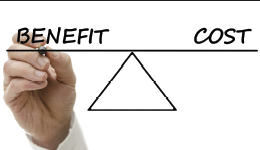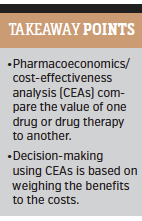Pharmacoeconomics: Weighing the Benefits to the Costs
 The use of a cost-effectiveness analysis (CEA) in medical decision-making is increasing as health care delivery moves from volume-based reimbursement models to value-based models. Pharmacoeconomics/CEAs compare the value of one drug or drug therapy to another. They are used for formulary decision-making, therapeutic guideline determination, individual patient decisions, and, importantly, reimbursement/coverage decisions.
The use of a cost-effectiveness analysis (CEA) in medical decision-making is increasing as health care delivery moves from volume-based reimbursement models to value-based models. Pharmacoeconomics/CEAs compare the value of one drug or drug therapy to another. They are used for formulary decision-making, therapeutic guideline determination, individual patient decisions, and, importantly, reimbursement/coverage decisions.
“Health care reform has required methods to evaluate economic and societal value of goods and services,” said Renee JG Arnold, PharmD, practice lead, health economics and outcomes research, Quorum Consulting. “Pharmacoeconomics/CEAs evaluate value for money expended on health care technologies.”
In her presentation at AMCP, Arnold described different types of CEAs currently used to evaluate health care technologies that assess a treatment’s cost, effectiveness, and benefits. Decision-making using CEAs is based on weighing the benefits to the costs.
For clinical decisions that cannot be supported definitively by clinical evidence, decision-analytic modeling can be used if enough data is available to compare at least 2 clinical strategies with tradeoffs (ie, benefits and cost). This type of modeling incorporates probabilities and costs of likely events for expected therapeutic pathways.
Arnold described the application of a decision tree to calculate the expected outcomes of cost and effectiveness using the decision-analytic model. Integral to this model and use of a decision tree is running a sensitivity analysis to test the stability of the overall analysis over a range of probability estimates and value, which, she said, allows a determination of the robustness of the model and “helps us see if a decision relies heavily on a particular variable.”
To illustrate the use of CEAs in clinical decision-making, she walked through an example of a study that assessed the cost-effectiveness of echinoderm microtubule-associated protein like 4 (EML4)-anaplastic lymphoma kinase (ALK) fusion testing and first-line crizotinib  monotherapy for patients with advanced ALK-positive non-small-cell lung cancer (NSCLC) by comparing it to SOC (cisplatin + gemcitabine as first-line therapy, premetrexed as second-line, and erlotinib as third-line) [Djalalov S, Beca J, Hoch JS, et al. Cost effectiveness of (EML4)-ALK fusion testing and first-line crizotinib treatment for patients with advanced ALK-positive non-small-cell lung cancer. J Clin Oncol. 2014;32(10):1012-9].
monotherapy for patients with advanced ALK-positive non-small-cell lung cancer (NSCLC) by comparing it to SOC (cisplatin + gemcitabine as first-line therapy, premetrexed as second-line, and erlotinib as third-line) [Djalalov S, Beca J, Hoch JS, et al. Cost effectiveness of (EML4)-ALK fusion testing and first-line crizotinib treatment for patients with advanced ALK-positive non-small-cell lung cancer. J Clin Oncol. 2014;32(10):1012-9].
An ALK mutation is a fusion of the genes ALK and EML4, which codes for an abnormal protein called tyrosine kinase. Simplistically, tyrosine kinase “drives” the growth of a cancer (mutations such as the EML4-ALK fusion gene are known as “driver mutations”). The study used a cost-utility model that assessed the ratio of cost to effectiveness, and evaluated additional cost for additional unit of effectiveness. Based on this model, the study found that EML4-ALK fusion testing in stage IV nonsquamous NSCLC with crizotinib treatment for ALK-positive patients was not cost effective taking into account the high costs of drugs and low biomarker frequency in the study populations. According to Arnold, the findings did suggest that more targeted use of crizotinib treatment, especially in selected subpopulations, may improve cost-effectiveness.













